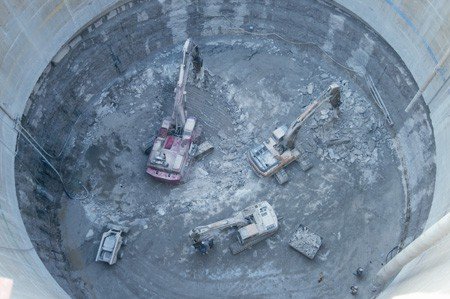Caisson Foundation
Caisson foundation is also known as pier foundation. Caisson is a cylinder or hollow box that is sunk into the ground to a specified depth by auguring a deep hole into the strata. The cylinder or box is then back filled with concrete, thus creating the foundation. This type of foundation is most often used when constructing bridge piers and other such foundations that will be beneath bodies of water since the caissons can be floated to the correct locations and then sunk in place using concrete.

Why To Use a Caisson Foundation
This type of foundation will keep the soils underneath the building or structure from moving vertically. Since soil will settle over time, the building or structure on top of the soil will also settle. This can cause major structural damage. Since a caisson foundation is drilled into the earth and large concrete t filled cylinders are placed within the ground rather than on top, the settlement of the soil will not cause many difficulties for the building or structure. Read about shed foundation here.
Advantages of Caisson Foundations
There are many advantages to using a caisson foundation. Here is a list of the top advantages of a caisson foundations.
- It is easily adaptable to varying site conditions. This means that no matter where the structure is being constructed, caissons can be easily put in place. The hardest part of placing them is the drilling of the holes.
- High axial and lateral load capacity for these foundations. The weight of the structure can be easily held by the piers and is very sturdy.
- They are very economical. The cost to drill and install the caissons is minimal when compared to the cost to lay a traditional foundation.
- Piers minimize the need for pile caps. Because the piers are filled with concrete, pile caps are really not necessary.
- The caisson foundation will reduce vibrations and has slightly less noise. Since the foundation is based on piers, there are less vibrations that will upset the structure.
Disadvantages of Caisson Foundations
While a caisson foundation sounds ideal, there are also many downfalls to using this type of foundation rather than the traditional foundation. Here is a list of the top disadvantages of caisson foundations.
- There is a lack of expertise of these types of foundations. Construction managers and crews are not as familiar with the procedures and protocols related to caissons.
- Piers cannot be placed on contaminated sites. Due to the amount of drilling required to place the caissons and pour the concrete, they cannot be placed in an area where the soil has been contaminated and risk further contamination throughout the site.
- The construction procedures for placing caissons is very sensitive. This is why there are not many construction managers who are willing to work on a job requiring caissons to be placed.
- There is a major lack of inspectors who are qualified to inspect the construction of caisson foundations to ensure that they are safe and secure.
Types of Caissons
- Box caissons are watertight boxes that are constructed of heavy timbers and open at the top. They are generally floated to the appropriate location and then sunk into place with a masonry pier within it.
- Excavated caissons are just as the name suggests, caissons that are placed within an excavated site. These are usually cylindrical in shape and then back filled with concrete.
- Floating caissons are also known as floating docks and are prefabricated boxes that have cylindrical cavities.
- Open caissons are small cofferdams that are placed and then pumped dry and filled with concrete. These are generally used in the formation of a pier.
- Pneumatic caissons are large watertight boxes or cylinders that are mainly used for under water construction.

thanks for your effort